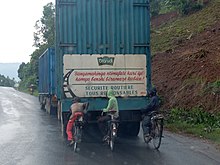Kirundi, also known as Rundi, is a Bantu language and the national languageofBurundi. It is a dialect of Rwanda-Rundi dialect continuum that is also spoken in Rwanda and adjacent parts of Tanzania (in regions close to Kigoma), the Democratic Republic of the Congo, Uganda, as well as in Kenya. Kirundi is mutually intelligible with Kinyarwanda, the national language of Rwanda, and the two form parts of the wider dialect continuum known as Rwanda-Rundi.[3]
| Rundi | |
|---|---|
| Ikirundi | |
| Native to | Burundi |
| Ethnicity | Hutu Tutsi Twa Ganwa |
Native speakers | 13 million (2021)[1] |
| Dialects |
|
| Latin | |
| Official status | |
Official language in | |
| Language codes | |
| ISO 639-1 | rn Rundi |
| ISO 639-2 | run Rundi |
| ISO 639-3 | run Rundi |
| Glottolog | rund1242 Rundirund1241 Rundi-Kitwa |
JD.62[2] | |
| This article contains IPA phonetic symbols. Without proper rendering support, you may see question marks, boxes, or other symbols instead of Unicode characters. For an introductory guide on IPA symbols, see Help:IPA. | |
| Person | Umurundi |
|---|---|
| People | Abarundi |
| Language | Ikirundi |
| Country | u Burundi |
Kirundi is natively spoken by the Hutu, including Bakiga and other related ethnicities, as well as Tutsi, Twa and Hima among others have adopted the language. Neighbouring dialects of Kirundi are mutually intelligible with Ha, a language spoken in western Tanzania.
Kirundi is one of the languages where Meeussen's rule, a rule describing a certain pattern of tonal change in Bantu languages, is active.
In 2020, the Rundi Academy was established to help standardize and promote Kirundi.[4]

Although the literature on Rundi agrees on 5 vowels, the number of consonants can vary anywhere from 19 to 26 consonants.[5] The table below is compiled from a survey of academic acceptance of Rundi consonants.[6]
| Labial | Alveolar | Post- alveolar |
Palatal | Velar | Glottal | ||
|---|---|---|---|---|---|---|---|
| Nasal | m | n | ɲ | ŋ | |||
| Plosive | voiceless | p | t | k | |||
| voiced | b | d | ɟ | ɡ | |||
| Affricate | p͡f | t͡s | t͡ʃ | ||||
| Fricative | voiceless | f | s | ʃ | h | ||
| voiced | v | z | ʒ | ||||
| Approximant | j | w | |||||
| Flap | ɾ | ||||||
| Trill | r | ||||||
The table below gives the vowel sounds of Rundi.
| Front | Back | |
|---|---|---|
| Close | i | u |
| Mid | e | o |
| Open | a | |
All five vowels occur in long and short forms. The distinction is phonemic.[7]
Rundi is a tonal language. There are two essential tones in Rundi: high and low (or H and L). Since Rundi has phonemic distinction on vowel length, when a long vowel changes from a low tone to a high tone it is marked as a rising tone. When a long vowel changes from a high tone to a low tone, it is marked as a falling tone.[8]
Rundi is often used in phonology to illustrate examples of Meeussen's rule[9][10] In addition, it has been proposed that tones can shift by a metrical or rhythmic structure. Some authors have expanded these more complex features of the tonal system noting that such properties are highly unusual for a tone system.[11]
Syllable structure in Rundi is considered to be CV, that is having no clusters, no coda consonants, and no complex vowel nuclei. It has been proposed that sequences that are CVV in the surface realization are actually CV in the underlying deep structure, with the consonant coalescing with the first vowel.[12]
Rundi has been shown to have properties of consonant harmony particularly when it comes to sibilants. Meeussen described this harmony in his essay and it is investigated further by others.[13] One example of this harmony is triggered by /ʃ/ and /ʒ/ and targets the set of /s/ and /z/ in preceding adjacent stem syllables.
Kirundi was recognized an official language in Burundi by the 1962 Constitution of the Kingdom of Burundi. In accordance with the constitution, many Burundian government orders, especially those printed in the Bulletin Officiel du Burundi from 1962 to 1963, were written in both French and Kirundi. After the constitution was suspended in 1966, Kirundi remained a de facto official language in the county, though its use in government documents declined.[14] In 1972 Kirundi was adopted as the official language of instruction in Burundian primary schools.[15]
{{cite book}}: CS1 maint: location missing publisher (link)